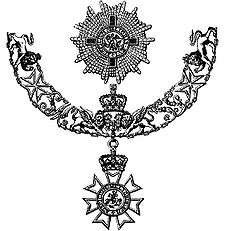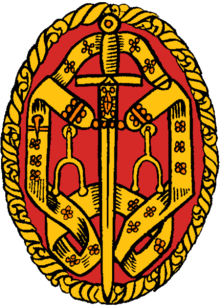Australian honours system
The Australian honours system consists of a number of orders, decorations, and medals through which the country's sovereign awards its citizens for actions or deeds that benefit the nation. Established in 1975 with the creation of the Order of Australia, the system's scope has grown since then and over time has replaced the Imperial/British honours system that previously applied to Australians. The system includes an array of awards, both civil and military, for gallantry, bravery, distinguished service, meritorious service, and long service. Various campaign and commemorative medals have also been struck. New honours can be awarded at any time, but conventionally most new honours are awarded on Australia Day and on the Queen's Birthday (as observed in the eastern states, that is, on the second Monday in June) every year, when lists of new honours are published.
History
The Australian states and the Commonwealth of Australia originally used the Imperial honours system, also known as the British honours system. The creation in 1975 of the Australian Honours System saw Australian recommendations for the Imperial awards decline, with the last awards being gazetted in 1989. The Commonwealth of Australia ceased making recommendations for Imperial awards in 1983, with the last Queen's Birthday Australian Honours list submitted by Queensland and Tasmania in 1989. The Queen still confers upon Australians honours that emanate from her personally such as the Royal Victoria Order, apart from the Order of Australia. Only a handful of peerages and baronetcies were created for Australians. Some were in recognition of public services rendered in Britain rather than Australia. Hereditary peerages and baronetcies derive from Britain. There have never been Australian peerages or baronetcies created under the Australian Crown.[1]
Individual Australian states, as well the Commonwealth Government, were full participants in the Imperial honours system. Originally there was bipartisan support, but Australian Labor Party (ALP) governments, both national and state, ceased making recommendations for Imperial awards – in particular, appointments to the Order of the British Empire mainly after 1972. During the Second World War, the Governor-General, on the advice of wartime Labor governments, made recommendations for gallantry awards, including eleven for the Victoria Cross. Appointments to the Order of the British Empire were for officers and men engaged in operational areas.
In 1975, the ALP (which had been out of power federally from 1949 until 1972) created the Australian Honours System. Recommendations were processed centrally, but State Governors still had the power, on the advice of their governments, to submit recommendations for Imperial awards. From 1975 until 1983, the Liberal Party was in power federally, under Malcolm Fraser and, although it retained the Australian Honours System, it reintroduced recommendations for meritorious Imperial awards, but not for Imperial awards for gallantry, bravery or distinguished service. Recommendations for Imperial awards by the Federal Government ceased with the election of the Hawke Labor Government in 1983. In 1989, the last two states to make Imperial recommendations were Queensland and Tasmania.[2] The defeat of both governments at the polls that year marked the end of Australian recommendations for Imperial awards.
Following the UK New Year Honours List in 1990, which contained no Australian nominations for British honours, the Queen's Private Secretary, Sir William Heseltine, wrote to the Governor-General, saying "this seems a good moment to consider whether the time has not arrived for Australia, like Canada, to honour its citizens exclusively within its own system". There followed more than two years of negotiations with State governments before the Prime Minister, Paul Keating, made the announcement on 5 October 1992 that Australia would make no further recommendations for British honours.[3] The Australian Order of Wear states that "all imperial British awards made to Australian citizens after 5 October 1992 are foreign awards and should be worn accordingly".[4]
The Australian Honours System has followed United States rather than British practice in allowing for late awards years after an action that is being commended. More than one hundred late awards for the Second World War and Vietnam have been gazetted.[5] Although 'The Report of the inquiry into unresolved recognition for past acts of naval and military gallantry and valour' released in March 2013 did not recommend any belated Victoria Cross for Australia awards, it did recommend a Unit Citation for Gallantry to HMAS Yarra for February and March 1942.[6] Similarly, Australian Bravery Awards have been gazetted years after the action being commended, including a Commendation for Brave Conduct awarded in 1987 to Robert Anderson for his courage in rescuing a child from a burning car at Kalgoorlie eight years earlier in 1979.[7]
Nominating or applying for awards
Australians become recipients of each of the 55 different types of Australian awards and honours through one of two separate processes; by nomination or by application.[8]
- Nomination: Individual nominations may be made by members of the public or a community group for the Order of Australia and Australian Bravery Decorations. Nominations for Meritorious Service Awards are based on nominations from each specific organisation. The Department of Defence also nominates individuals for a range of service decorations.[8] Non-Australians can be given honorary awards for "extraordinary service to Australia or humanity at large".[9] Nomination forms for the Order of Australia are available through the Australian Honours Secretariat website, or upon application to the Honours Secretariat at Government House, Canberra or from any state Government House.
- Application: Many of the honours or awards are based on an application by the recipient or a recommendation on their behalf. Awards that fall under this category include service awards for defence force and police personnel for operational service or to other individuals for special civilian services recognised by the Australian Government. Unlike Imperial bravery or gallantry awards, any person can nominate themselves for an Australian Bravery Award under the current design of the nomination form.[8]
Categories of honours and awards
There are two broad categories of honours and awards.
Individual honours and awards
The Honours and the Awards in the Australian system are, and have been:
- those within the Australian System of Honours and Awards;
- those conferred by The Sovereign in exercise of the Royal Prerogative;
- those within the Order of St John;
- Imperial/British awards conferred before 6 October 1992; and
- foreign awards, the acceptance and wearing of which have been authorised by the Governor-General.
Note that awards of the British Empire/United Kingdom are now foreign awards.[10]
Military theatre and battle honours, honour titles and distinctions
The Australian Defence Force has a system of battle honours, theatre honours, honour titles and honour distinctions to recognise exemplary service by units (not individuals) in combat and combat-related roles. Normally, Defence Honours are not awarded below sub-unit level (an organisation normally commanded by a Major or equivalent). The recommendation for the award of battle honours, theatre honours, honour titles and honour distinctions is made by a Battle Honours Committee.[11]
There are four categories of honours in the Defence system as follows:[11]
- Theatre Honour: A theatre of operations is defined as a geographic area in which a campaign or series of operations is conducted and for which an operational level joint or combined commander is appointed. A Theatre Honour can be made where a unit or sub-unit of any Corps is deployed under warlike conditions. Any unit that qualifies for a Battle Honour will automatically also qualify for a Theatre Honour. Examples of Theatre Honours awarded to Australian units include Gallipoli 1915, France and Flanders 1914–1918, Middle East 1941–1944, South West Pacific 1942–1945, Korea 1950–1953 and Vietnam 1965–1972.[11]
- Battle Honour: A battle is an operational action conducted under warlike conditions. A Battle Honour is defined as the title of a battle or a series of battles fought as a campaign, an action or an engagement and is awarded to close combat elements of a Combat Corps of the Australian Army, Australian Navy or Royal Australian Air Force as a public commemoration of outstanding achievement in battle(s), action or engagement. Examples of Battle Honours awarded to Australian units include the Landing at Anzac Cove, Hamel, Tobruk, Kokoda Track, Kapyong and Coral-Balmoral.[11][12]
- Honour Title: An Honour Title is awarded to any non-combat unit or sub-unit that is not entitled to a Battle Honour but which satisfies the same requirements for the award of a Battle Honour. An example of the award of an Honour Title is the title Coral, awarded to 102nd Field Battery for its outstanding achievement during the Battle of Coral–Balmoral in South Vietnam.[11][13]
- Honour Distinction: An Honour Distinction is defined as a public commemoration of creditable performance by a unit or sub-unit in an operation which does not attract a Theatre, Battle or Honour Title. Honour Distinctions are intended to recognise service under operational conditions in security-related, peace keeping and peace enforcement and similar operations. The first award of an Honour Distinction was the award made to the 17th Construction Squadron for the Australian contribution to the United Nations Transition Assistance Group (UNTAG) peacekeeping mission in Namibia in 1989 and 1990.[14][15]
It is common that units claim Honours from original units with a historical connection to a military predecessors of the current Unit. For example, 4th/3rd Battalion, Royal New South Wales Regiment which is a modern amalgamated unit, is entitled to the previous Honours of the 3rd Battalion, the 4th Battalion as well as the World War I Honours of the 3rd and 4th Battalions First Australian Imperial Force. The term Battle Honour can be used to denote both battle and theatre honours.[11]
Historically the system was drawn from the British system adopted during World War I but has been modified since. A relatively recent change is the introduction of the Honours for recognition of outstanding service in dangerous operations short of declared theatres of war.[16] Defence also has a process of Defence and Service Commendations and other honours including the Army Combat Badge and Infantry Combat Badge which are awarded by Army Headquarters.[17][18]
Australian honours and awards
Order of Australia
The Order of Australia insignia were designed by Stuart Devlin in 1976. Devlin used the livery colours of the Australian Coat of Arms, gold and royal blue. He also translated an individual ball of wattle blossom into a simple convex golden disc with a rich texture of beads and radiating lines accentuating a ring of blue enamel representing the sea.
The disc is surmounted by an enamel Crown signifying the position of The Order of Australia as an Australian Royal Honour. The Sovereign is Head of the Order of Australia. The Governor-General is Principal Knight or Dame and Chancellor of the Order of Australia. The blue and gold theme is continued in the ribbon. Most of the insignia pieces are produced by the Royal Australian Mint in Canberra. The actual pieces for the two Divisions of the Order are identical: it is only the ribbon which differentiates an award between the General and the Military Divisions. In the Military Division the ribbon is distinguished by the addition of a narrow gold band on each edge.
When established, only the grades of Member, Officer and Companion of the Order existed. In 1976, Malcolm Fraser recommended to the Queen the addition of the Medal and grade of Knight and Dame in the Order. The grade of Knight and Dame was removed on the advice of Prime Minister Bob Hawke in 1986 without prejudice to any person who had been admitted to the Order at that grade. The grade of Knight and Dame was restored on the advice of Tony Abbott in March 2014. Currently there are four grades within the Order in both Military and General Divisions, and an additional grade of Knight and Dame within the General Division only. People cannot be admitted to the Order posthumously; if a person is successfully nominated but dies prior to the scheduled announcement, the date of effect of the award is deemed to be a date before they died.
The Council for the Order of Australia makes recommendations to the Governor-General as to the appropriateness of a nominee to be admitted to the Order and at what grade. It is up to the Honours Secretariat to provide the council with as much fully verified information as is possible on each nominee so that appropriate consideration may be given to each case. This is a long process and up to eighteen months can elapse between the original submission and publication of a successful nomination.
-
 General Division ribbon
General Division ribbon -
_ribbon.png) Military Division ribbon
Military Division ribbon
Classes
- Knight / Dame of the Order of Australia (AK / AD)
- Appointments to this class of the Order ceased between 3 March 1986 and 25 March 2014. A maximum of four knights and dames were appointed each year. In November 2015, the Australian government announced that the Queen approved the Government's request to amend the Order's letters patent and cease awards in this class, after Cabinet agreed that the titles are no longer appropriate in the modern awards system.[19][20] The full list is at List of Knights and Dames of the Order of Australia.
- Companion of the Order of Australia (AC)
- Appointments are made for eminent achievement and merit of the highest degree in service to Australia or to humanity at large. Excluding honorary appointments, no more than 25 Companions shall be appointed in any calendar year. The full list is at List of Companions of the Order of Australia.
- Officer of the Order of Australia (AO)
- Appointments made for distinguished service of a high degree to Australia or to humanity at large. Excluding honorary appointments, no more than 100 Officers shall be appointed in any calendar year.
- Member of the Order of Australia (AM)
- Appointment made for service in a particular locality or field of activity or to a particular group. Excluding honorary appointments, no more than 225 Members shall be appointed in any calendar year.
- Medal of the Order of Australia (OAM)
- Awarded for service worthy of particular recognition. There is no quota limit on awards of the Medal of the Order.
Knights and Dames
Bold names are living recipients. These have included:
| Order | Foundation | Motto | Chancellor | |
|---|---|---|---|---|
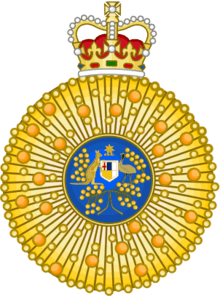 |
Order of Australia | 1975 – Elizabeth II | His Excellency General The Honourable Sir Peter Cosgrove AK, MC | |
| Knights/(Dames) (AK/AD): Sir John Kerr (1976), Sir Robert Menzies (1976), Sir Colin Syme (1977), Sir Zelman Cowen (1977), Sir Macfarlane Burnet (1978), Dame Alexandra Hasluck (1978), Dame Enid Lyons (1980), Charles, Prince of Wales (1981), Sir Roden Cutler (1981), Sir Garfield Barwick (1981), Sir Charles Court (1982), Sir Ninian Stephen (1982), Sir Roy Wright (1983), Sir Gordon Jackson (1983), Dame Quentin Bryce (2014), Sir Peter Cosgrove (2014), Dame Marie Bashir (2014), Prince Philip, Duke of Edinburgh (2015), Sir Angus Houston (2015) | ||||
Gallantry
-
_ribbon.png) Victoria Cross for Australia (VC)
Victoria Cross for Australia (VC) -
 Star of Gallantry (SG)
Star of Gallantry (SG) -
 Medal for Gallantry (MG)
Medal for Gallantry (MG) -
_ribbon.png) Commendation for Gallantry
Commendation for Gallantry
Bravery
-
 Cross of Valour (CV)
Cross of Valour (CV) -
 Star of Courage (SC)
Star of Courage (SC) -
 Bravery Medal (BM)
Bravery Medal (BM) -
_ribbon.png) Commendation for Brave Conduct
Commendation for Brave Conduct -
.jpg) Group Bravery Citation
Group Bravery Citation
Distinguished/Conspicuous/Nursing Service
Distinguished Service
-
_ribbon.png) Distinguished Service Cross (DSC)
Distinguished Service Cross (DSC) -
_ribbon.png) Distinguished Service Medal (DSM)
Distinguished Service Medal (DSM) -
_ribbon.png) Commendation for Distinguished Service
Commendation for Distinguished Service
Conspicuous Service
-
 Conspicuous Service Cross (CSC)
Conspicuous Service Cross (CSC) -
 Conspicuous Service Medal (CSM)
Conspicuous Service Medal (CSM)
Nursing Service
-
 Nursing Service Cross (NSC)
Nursing Service Cross (NSC)
Meritorious Service
-
 Public Service Medal (PSM)
Public Service Medal (PSM) -
 Australian Police Medal (APM)
Australian Police Medal (APM) -
 Australian Fire Service Medal (AFSM)
Australian Fire Service Medal (AFSM) -
 Ambulance Service Medal (ASM)
Ambulance Service Medal (ASM) -
 Emergency Services Medal (ESM)
Emergency Services Medal (ESM) -
 Australian Antarctic Medal (AAM)
Australian Antarctic Medal (AAM)
Campaign and Overseas Service
-
 Australia Service Medal 1939–45
Australia Service Medal 1939–45 -
_ribbon.png) Civilian Service Medal 1939–1945
Civilian Service Medal 1939–1945 -
 Australian Active Service Medal 1945–1975
Australian Active Service Medal 1945–1975 -
 Australian Service Medal 1945–1975
Australian Service Medal 1945–1975 -
 Australian Active Service Medal
Australian Active Service Medal -
 Australian General Service Medal Korea
Australian General Service Medal Korea -
 Australian Service Medal
Australian Service Medal -
 Vietnam Medal
Vietnam Medal -
 Vietnam Logistic and Support Medal
Vietnam Logistic and Support Medal -
 International Force East Timor Medal (INTERFET)
International Force East Timor Medal (INTERFET) -
 Rhodesia Medal
Rhodesia Medal -
_ribbon.png) Police Overseas Service Medal
Police Overseas Service Medal -
_ribbon.png) Humanitarian Overseas Service Medal
Humanitarian Overseas Service Medal -
_ribbon.png) Afghanistan Medal
Afghanistan Medal -
_ribbon.png) Iraq Medal
Iraq Medal -
Operational Service Medal for Border Protection
-
 Operational Service Medal for Greater Middle East Operation
Operational Service Medal for Greater Middle East Operation -
 Australian Operational Service Medal (Civilian variant)
Australian Operational Service Medal (Civilian variant)
Special Service
Commemorative
-
 80th Anniversary Armistice Remembrance Medal[24]
80th Anniversary Armistice Remembrance Medal[24] -
 Australian Sports Medal[25]
Australian Sports Medal[25] -
_ribbon.png) Centenary Medal[26]
Centenary Medal[26] -
_ribbon.png) Anniversary of National Service 1951–1972 Medal[27]
Anniversary of National Service 1951–1972 Medal[27]
Long Service
-
_ribbon.png) Defence Force Service Medal
Defence Force Service Medal -
_ribbon.png) Reserve Force Decoration (RFD)
Reserve Force Decoration (RFD) -
_ribbon.png) Reserve Force Medal
Reserve Force Medal -
_ribbon.png) Defence Long Service Medal
Defence Long Service Medal -
_ribbon.jpg) National Medal
National Medal -
_ribbon.png) Australian Cadet Forces Service Medal
Australian Cadet Forces Service Medal
Champion Shots
Royal honours
The Sovereign confers honours upon Australians in exercise of the Royal Prerogative (rather than through the government). Bold names are living recipients. These have included:
Imperial honours
Imperial honours awarded to Australians since 5 October 1992 are no longer part of the Australian honours system, and are foreign awards. Bold names are living recipients.
Prior to 6 October 1992, such honours were part of the Australian system (and awards made prior to that date still retain legal recognition in Australia):
Foreign honours – including UN and NATO service
Specific foreign awards are not mentioned on the Order of Wear document – just the general comment that foreign awards appear after the awards mentioned.
A list of foreign honours commonly awarded to Australians appears at Australian Honours Order of Wearing#Foreign awards.
A list of foreign awards commonly awarded to Australians for campaign and peacekeeping service appears at Australian Campaign Medals#Foreign awards.
Permission for formal acceptance and wearing of foreign awards is given by the Governor-General on the recommendation of the Prime Minister or the Minister responsible for Australian honours.[31]
Additional information regarding UN medals can be found on the Australian Defence Force website.[32]
See also
- Australian Honours Order of Wearing
- Australian campaign medals
- List of post-nominal letters (Australia)
- Australian of the Year
- British honours system
- A list of surviving Australian knights and dames
- A list of all Australian knights and dames
- Australian Commendations
- Queensland Honours
References
- ↑ Who's Who Australia 2008. Details are provided at Australian peers and baronets.
- ↑ London Gazette, 17 June 1989, pp. B29 & B30
- ↑ A matter of honour: the report of the review of Australian honours and awards, December 1995, pp. 21–22
- ↑ "The Order of Wearing Australian Honours and Awards" (PDF). Special Gazette No. S192. Commonwealth of Australia. 28 September 2007.
- ↑ In the British system, no Victoria Cross has been awarded more than six years after the action commended. The longest period between action and award of the US Medal of Honor is 137 years, when in January 2001 President Bill Clinton presented the Medal of Honor to descendants of a Civil War soldier.
- ↑ "HMAS Yarra". Defence Honours and Awards Appeals Tribunal. Australian Government. Retrieved 8 October 2015.
- ↑ Commendation for Brave Conduct, ANDERSON, Robert Graham, 30 January 1987, It's an Honour
- 1 2 3 "Nominating or Applying for Awards". Australian Government. Retrieved 17 June 2013.
- ↑ "Order of Australia". Medals Australia. Archived from the original on 1 December 2006. Retrieved 2007-01-01.
- ↑ "- all Imperial awards made to Australian citizens after 5 October 1992 are foreign awards and should be worn accordingly." Order of Wearing, updated 25 September 2007. page 1. (Generally, foreign awards are worn after Australian awards, and postnominals of foreign awards are not recognised.)
- 1 2 3 4 5 6 Administration of Australian Battle Honours, Theatre Honours, Honour Titles and Honour Distinctions. Defence Instruction (Army). 38–3 (ADMIN ed.). Canberra: Australian Army. 4 May 2012.
- ↑ "Australian Army Corps Badges". Australian Department of Defence. Retrieved 2007-03-30.
- ↑ McAulay, Lex (1988). The Battle of Coral: Vietnam Fire Support Bases Coral and Balmoral, May 1968. London, England: Arrow Books. ISBN 0-09-169091-9.
- ↑ Morrison, David (10 April 2012). "Letter from the Chief of Army to the Governor General of Australia" (PDF). Army Headquarters, Canberra: 2. OCA/OUT/2012/R11194182. Archived from the original (PDF) on 16 June 2013.
- ↑ Morrison, David (10 August 2012). "Letter from the Chief of Army to the Officer Commanding 17th Construction Squadron" (PDF). Army Headquarters, Canberra: 2. OCA/OUT/2012/R11944295.
- ↑ John Wellfare, ed. (23 May 2013). "Honour for engineers: First Honour Distinction has been awarded to 17 Const Sqn for Namibia 1989-90 peacekeeping mission" (PDF) (1305 ed.). Army Headquarters, Canberra: 4. Retrieved 18 June 2013.
- ↑ "Army Combat Badge" (PDF). DI(A) PERS 119-1 Issue: 5/2009. Department of Defence (Army Headquarters). 24 August 2009.
- ↑ "Who is eligible for the Infantry Combat Badge". Defence Medals FAQ. defence.gov.au.
- ↑ Norman, Jane; Iggulden, Tom (2 November 2015). "Knights and dames scrapped from Order of Australia, Malcolm Turnbull says". ABC News. Australia. Retrieved 2 November 2015.
- ↑ Medhora, Shalailah (2 November 2015). "Knights and dames removed from Order of Australia by Malcolm Turnbull". The Guardian. Australia. Retrieved 2 November 2015.
- ↑ National Police Service Medal, It's an Honour – Australian Government Website
National Police Service Medal fact sheet, It's an Honour – Australian Government Website - ↑ Australian Defence Medal, It's an Honour – Australian Government Website
Australian Defence Medal fact sheet, It's an Honour – Australian Government Website - ↑ National Emergency Medal regulations, The Australian Honours Secretariat – Governor General of Australia's site. Archived 30 January 2012 at the Wayback Machine.
- ↑ "80th Anniversary Armistice Remembrance Medal". A-Z of Awards. Itsanhonour.gov.au. Retrieved 5 December 2010.
- ↑ "Australian Sports Medal". A-Z of Awards. Itsanhonour.gov.au. Retrieved 5 December 2010.
- ↑ "Centenary Medal". A-Z of Awards. Itsanhonour.gov.au. Retrieved 5 December 2010.
- ↑ "Anniversary of National Service 1951–1972 Medal". A-Z of Awards. Itsanhonour.gov.au. Retrieved 5 December 2010.
- ↑ "MSM Awards". Honours.homestead.com. 13 September 1988. Retrieved 2010-12-05.
- ↑ The first award of the Victoria Cross for Australia was in 2009.
- ↑ Presentation of The Queen’s Diamond Jubilee medal to Corporal Daniel Keighran VC, gg.gov.au
- ↑ Foreign Awards, www.itsanhonour.gov.au
- ↑ Australian Issue of UN Medals, www.defence.gov.au
Bibliography
- Bruce Knox (1998). "Honours". In Graeme Davison, John Hirst and Stuart MacIntyre (eds.). The Oxford Companion to Australian History. Melbourne, Australia: Oxford University Press. ISBN 0-19-553597-9.
External links
- The Australian Government Honours and Awards Website
- The Defence Honours and Awards Manual (DHAM)
- Chapter 4 of the manual includes a link to the "current" (2007) Order of Wearing, but more usefully:
- Annex A contains: A modified order of wearing that is designed to make the order of wearing Defence awards more easily understood ... The modified version provides a complete list of all awards by incorporating those campaign and other medals that are included separately in annexes to the original schedule.
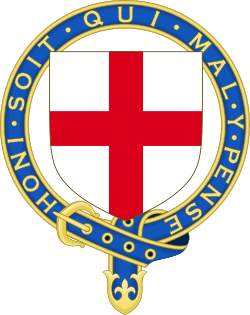
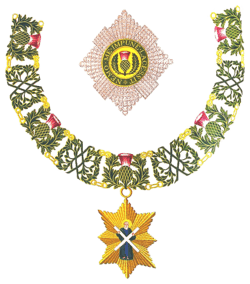
.jpg)


